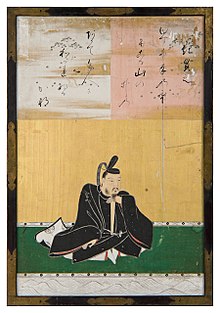Ki no Tsurayuki


Ki no Tsurayuki ( Japanese 紀 貫 之 ; * 872 ; † 945 ) was a Japanese writer, poet and courtier.
Life
Tsurayuki was the son of Ki no Mochiyuki . He became a waka poet in the 890s . In 905 he was one of the 4 poets who compiled the Kokin-wakashū , an anthology of poetry , by order of the Daigo- tennō .
After holding some offices in Kyoto , he was appointed provincial governor of Tosa Province and stayed there from 930 to 935. He was later probably transferred to Suō Province , as a record of a waka party he held in his home in Suō has come down to us.
He is famous for his waka and is regarded in Japan as one of 36 poetic immortals selected by Fujiwara no Kintō . He was also known as one of the editors of the Kokin-wakashū . Tsurayuki wrote one of the two forewords to this work, the second is in Chinese. His foreword was the first critical essay on waka. He dealt with the history of the waka from its mythological origin to the waka of its time. He grouped them into genres, referred to some important poets and criticized his predecessors, like Ariwara no Narihira, rather harshly.
His waka is included in the important Japanese poetry anthology Hyakunin Isshu , which was compiled long after his death in the 13th century.
Works
In addition to the Kokin-wakashū and its foreword, Tsurayuki's main literary work was the Tosa Nikki (Tosa Diary), which was written anonymously and in Hiragana characters . At the beginning of the diary, he pretended to be a woman, but the contents suggest that the author was male. The text describes a return trip from Tosa Province to Kyoto in 935, where Tsurayuki was provincial governor.
Tosa nikki was written in hiragana at a time when men usually did not use the "uneducated" and "feminine" hiragana and preferred kanji . However, he chose this means of expression because the central theme of the diary was not the journey, but the grief over the death of his daughter in Tosa. At the beginning of the text her death is not mentioned and scenes of the journey are described in a comical, semi-serious way. Later in the text, the deceased girl and the mourning over her absence are introduced. Tosa nikki is the oldest surviving diary in Cana. It is considered an exceptionally well-written work and has had a strong influence on later diary-style works.
There is an anthology of Tsurayuki's waka called Tsurayuki-shū . He probably put these together himself. Some of his works have also been included in other major waka anthologies such as Kokin-shū and other imperial collections. In the three oldest of the imperial waka anthologies, he was one of the most popular waka poets.
His name is mentioned in Genji Monogatari as a waka master. In this story, the Uda -tennō orders him and a number of female poets to write waka on door panels.
literature
- Ōoka Makoto: Ki no Tsurayuki and the imperial collections of poetry , in: Poetry and Poetics of Ancient Japan - five lectures at the Collège de France , Carl Hanser Verlag 2000, ISBN 3-446-19859-8
Web links
- Literature by and about Ki no Tsurayuki in the catalog of the German National Library
- e-texts of Tsurayuki's works on Aozora Bunko (engl.)
- An example of his poem from the Hyakunin Isshu 7 translations (Engl.)
| personal data | |
|---|---|
| SURNAME | Ki no Tsurayuki |
| ALTERNATIVE NAMES | 紀 貫 之 (Japanese) |
| BRIEF DESCRIPTION | Japanese writer poet and courtier |
| DATE OF BIRTH | 872 |
| DATE OF DEATH | 945 |